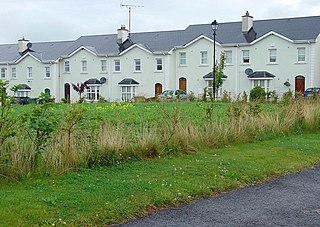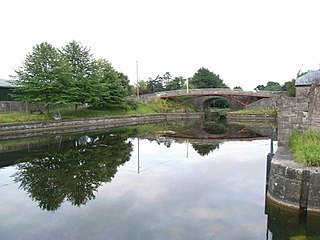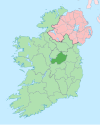
Multyfarnham or Multyfarnam is a village in County Westmeath, Ireland.

The River Inny is a river within the Shannon River Basin in Ireland. It is 88.5 kilometres (55.0 mi) in length, and has a number of lakes along its course.
Lough Iron is a small lake on the River Inny, in County Westmeath, Ireland.
Máel Íosa Ua Dálaigh was an Irish poet. He died in 1185.

Moygoish is a barony in north County Westmeath, in Ireland, formed by 1672. It is bordered by County Longford to the west and four other Westmeath baronies: Corkaree, Fore, Moyashel and Magheradernon and Rathconrath to the south–west.

Moyashel and Magheradernon is a barony in the centre of County Westmeath, in Ireland, formed by 1672. It is bordered by eight other baronies: Corkaree and Fore, Delvin and Farbill, Fartullagh and Moycashel and Rathconrath and Moygoish.

Ballinalack is a village and a townland in County Westmeath, Ireland. It is located about 14 kilometres (9 mi) north–west of Mullingar.
Cullenhugh is a townland in County Westmeath, Ireland. It is located about 13.5 kilometres (8 mi) north–west of Mullingar on the northeastern shore of Lough Iron. The River Inny forms its northwestern boundary.
Leny is a civil parish in County Westmeath, Ireland. It is located about 10.5 kilometres (7 mi) north–west of Mullingar. This name also applies to the townland of Leny; neither should be confused with the Falls of Leny in Scotland.
Lackan is a civil parish in County Westmeath, Ireland. It is located about 13 kilometres (8 mi) north–north–west of Mullingar. This name also applies to the townland of Lackan.

Portloman is a civil parish in County Westmeath, Ireland. It is located about 6.5 kilometres (4 mi) north–west of Mullingar in hilly country on the western shore of Lough Owel.
Stonehall is a civil parish in County Westmeath, Ireland. It is located about 9.6 kilometres (6 mi) north of Mullingar. This name also applies to the townland of Stonehall.
Tyfarnham is a civil parish in County Westmeath, Ireland. It is located about 7.5 kilometres (5 mi) north of Mullingar.

Multyfarnham is a civil parish in County Westmeath, Ireland. It is located about 12.3 kilometres (8 mi) north of Mullingar on the southwestern shore of Lough Derravaragh.

Mullingar is a civil parish in County Westmeath, Ireland. It includes Mullingar the county town of Westmeath, as well as the eponymous townland. Mullingar parish is located about 75 kilometres (47 mi) west of Dublin on the N4 road and the N52 road which meet east of Mullingar town. It is served by Mullingar railway station on the Dublin to Sligo line. The Royal Canal also passes through the parish and the town.
Ballynakill is a townland in County Westmeath, Ireland. It is located about 13.23 kilometres (8 mi) north of Mullingar on the western shore of Lough Derravaragh.
Multyfarnham is a village in County Westmeath, Ireland.
Clonava is a townland in County Westmeath, Ireland. It is located about 16.31 kilometres (10 mi) north of county town Mullingar.
Knockdrin is a townland in County Westmeath, Ireland. It is located about 6.34 kilometres (4 mi) north–north–east of Mullingar.

Culleen More is a townland in County Westmeath, Ireland. It is located about 3.84 kilometres (2 mi) north of Mullingar.













